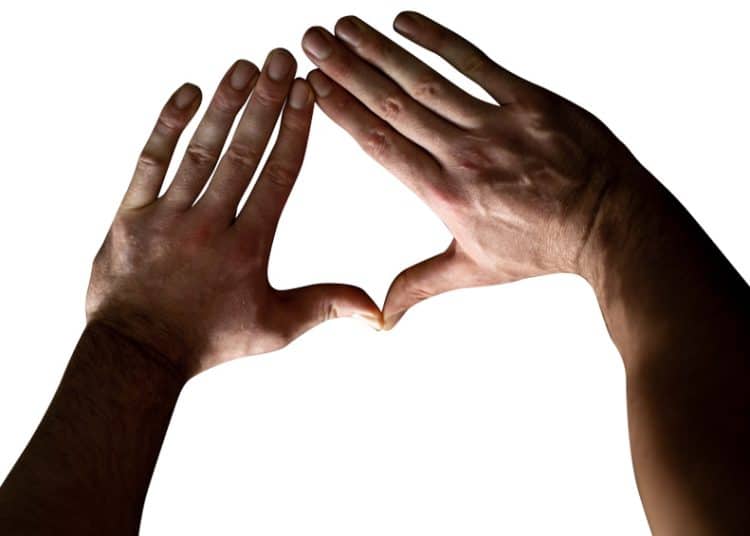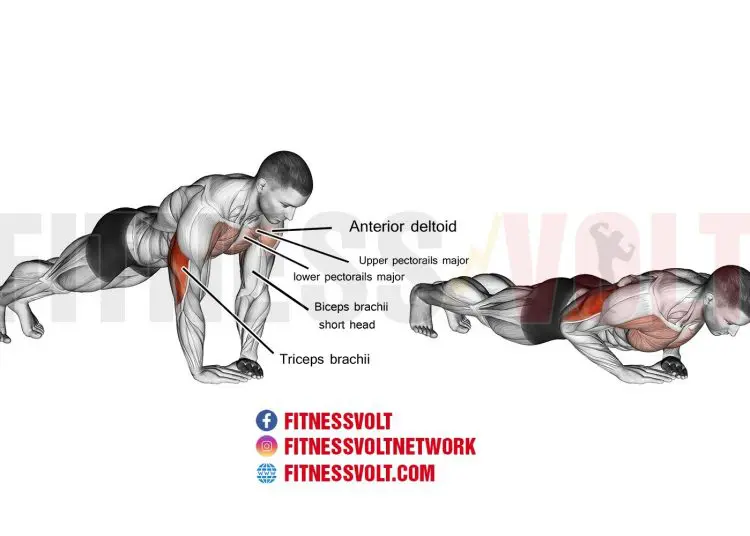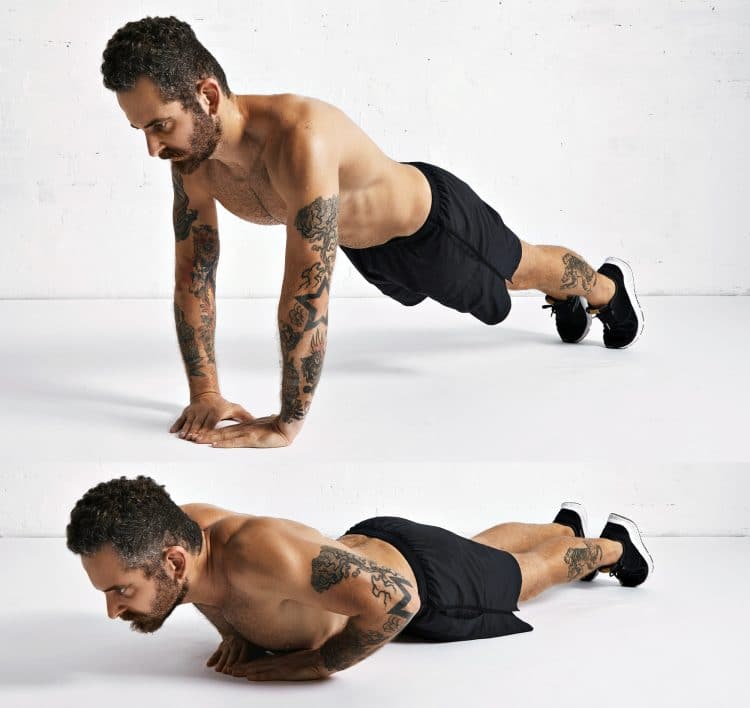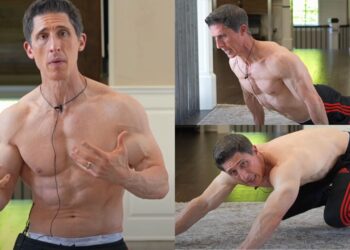The push-up is arguably the most widely-performed exercise in the world. Yes, the bench press is the crowned champion of strength training exercises, but it’s a safe bet that more people do push-ups. After all, everyone from elite athletes to the military to school kids in PT class does push-ups.
Regular push-ups are an effective exercise, but you don’t have to limit yourself to doing them exclusively. There are lots of push-up variations to try, and some are incredibly challenging.
While you might not be ready for single-arm or handstand push-ups, if you want to take your push-up workout to the next level, give diamond push-ups a try. They’re so-called because, when you place your hands on the floor, your thumbs and fingers form a diamond shape.

As well as being harder than regular push-ups, this exercise is great for building bigger, stronger triceps, too.
In this guide, we explain how to do diamond push-ups and reveal the seven best variations and alternatives.
Level Up Your Fitness: Join our 💪 strong community in Fitness Volt Newsletter. Get daily inspiration, expert-backed workouts, nutrition tips, the latest in strength sports, and the support you need to reach your goals. Subscribe for free!
Diamond Push-Ups – Muscles Worked

Diamond push-ups are a compound exercise. That means it involves multiple joints and muscle groups working simultaneously. The main muscles trained during diamond push-ups are:
Pectoralis major – known as the pecs for short, these are your primary chest muscles. The functions of the pecs are horizontal flexion, adduction, and medial rotation of the shoulder joint. Done with your feet on the floor, decline push-ups involve pushing slightly downward, which means they emphasize your lower pecs.
Deltoids – the deltoids are your shoulder muscles. There are three sets of deltoid fibers called heads: anterior/front, medial/middle, and posterior/rear. All three deltoid heads are involved in diamond push-ups, but the anterior deltoids are most active. The medial and posterior deltoids work primarily as shoulder stabilizers.
Triceps brachii – with your hands close together, diamond push-ups put a lot of stress on the triceps. In fact, triceps development is why most people do this exercise. The triceps are your main elbow flexor and are located on the back of your upper arm.
Core – to do diamond push-ups correctly, you need to keep your torso straight and rigid. This is the job of your core muscles. Core is the collective term for the muscles of your midsection: the rectus abdominis, inner and outer obliques, transverse abdominis, and erector spinae. These muscles contract inward to create intra-abdominal pressure or IAP for short, which supports your spine from within.
How to Do Diamond Push-Ups
Get more from diamond push-ups while keeping your risk of injury to a minimum by following these guidelines:
- Kneel down and place your hands flat on the floor, so your thumbs and first fingers form a triangle.
- With your arms extended, move your feet out and back until your body is straight. Brace your core, tuck your chin in, and lengthen your neck. Pull your shoulders down and back.
- Keeping your body straight, bend your arms and lower your chest down to the back of your hands. Keep your elbows close to your sides.
- Push back up and repeat.
- Bend your legs and rest on your knees to make this exercise easier. To make it harder, raise your feet and place them on a chair or exercise bench, or wear a weighted vest.
Variations & Tips
- If this variation is too difficult for you, try it on your knees or by pushing off from a wall.
- Do not arch your back during the exercise to keep all the resistance on the target muscles, and to protect your lower back.
- Make sure you’re pushing with your triceps during the exercise as the chest should only be a secondary mover.
- The diamond push-up is one of the best bodyweight tricep and chest (Secondary) exercises for building both size and strength.
Diamond Push-Up Benefits and Drawbacks
Not sure whether diamond push-ups are the exercise for you? Consider these benefits and then make your choice!
Anywhere, anytime – with no equipment and very little space required, you can do diamond push-ups almost anywhere. They’re ideal for home exercisers and the perfect excuse-free upper body workout.
Bigger, stronger triceps – diamond push-ups emphasize your triceps. Your pecs and delts are still involved, but you’ll definitely feel this exercise more in your upper arms. If you want to beef up your triceps or make them stronger, diamond push-ups could help.
Harder than regular push-ups – while regular push-ups are a great exercise, most people eventually progress to doing 20, 30, or even 50 reps at a time. Such high rep sets are not a good use of your training time. Diamond push-ups are significantly more demanding than regular push-ups. This makes them useful for increasing the difficulty of your workouts and saving you from doing such high-rep sets.
Easy to learn – push-ups are a pretty natural exercise that most people can pick up very quickly. As such, diamond push-ups are ideal for beginners. While they are a challenging exercise, less experienced exercisers can make them easier just by bending their knees.

While diamond push-ups are a beneficial exercise, there are also a few drawbacks to consider:
Joint pain – diamond push-ups put your hands and arms in a potentially awkward position. This could lead to elbow, shoulder, or wrist pain for some exercisers. If diamond push-ups cause joint pain, move your hands a little further apart for a more comfortable workout.
Limited overload – if you are very strong, you may find that diamond push-ups do not provide your muscles with enough overload to trigger increases in size or strength. While elevating your feet or wearing a weighted vest will make them harder, barbell exercises are arguably better for overloading the target muscles.
7 Diamond Push-Up Variations and Alternatives
Diamond push-ups are a highly effective upper body exercise, but that doesn’t mean you should do them all the time. There are several variations and alternatives you can use to keep your workouts productive and interesting:
1. Medicine ball push-ups
Medicine ball push-ups require and develop better balance, stability, and core strength than push-ups done on the floor. If you’ve mastered diamond push-ups and are ready for your next challenge, this could be the exercise for you. Like diamond push-ups, medicine ball push-ups are very triceps-dominant.
How to do it:
Level Up Your Fitness: Join our 💪 strong community in Fitness Volt Newsletter. Get daily inspiration, expert-backed workouts, nutrition tips, the latest in strength sports, and the support you need to reach your goals. Subscribe for free!
- Place a firm, non-slip medicine ball on the floor. Kneel down behind it and place your hands on the top at either side of the apex. Your fingers should be pointing down toward the floor.
- Keeping your arms straight, move your feet out and back into the push-up position. Brace your core and pull your shoulders down and back.
- Keeping your body straight, bend your arms and lower your chest to the ball.
- Push yourself back up and repeat.
- Make this exercise harder by placing your feet on a bench or chair or wearing a weighted vest. Alternatively, you can make it easier by bending your legs and resting on your knees.
2. Close grip barbell bench press
The bench press is arguably the most popular strength training exercise. Most people do bench presses to develop their pecs. But, if you move your hands closer together, your triceps have to do more of the work.
Like diamond push-ups, close grip barbell bench presses are a very effective triceps exercise.
Learn how to do close grip barbell bench presses here.
3. Close grip dumbbell bench press
The close grip dumbbell bench press is usually viewed as a chest exercise. While that’s undoubtedly true, like diamond push-ups, it’s also a great triceps builder.
But, unlike diamond push-ups, the close grip bench press is very shoulder, elbow, and wrist-friendly. No bench? No problem! You can also do this exercise on the floor, i.e., the close grip dumbbell floor press.
Read more about this effective exercise here.
4. Neutral grip Smith machine bench press
While many exercisers dislike the Smith machine, stating that it isn’t functional, it’s just another training tool you can use to build muscle and strength. Because the weight is guided on rods, the Smith machine leaves you free to focus on pushing your muscles to their limit in relative safety. While you could do close grip bench presses using a Smith machine, this neutral grip variation is more joint-friendly and provides a unique chest and triceps workout.
How to do it:
- Place a bench horizontally under the Smith machine bar. Lie on the bench, so the bar runs vertically up your body. Push a neutral grip handle up under the bar and hold it with both hands.
- Unrack the weight (you may need a training partner to do this for you), and then extend and bend your arms as usual. Keep your upper arms tucked into your sides.
- Rerack the weight, rest, and repeat.
5. Bodyweight skull crushers
Diamond push-ups aren’t the only bodyweight triceps exercise. You can also do skull crushers using nothing but your body weight for resistance. The main advantage of this exercise is that it provides more isolation for your triceps, which makes it both extra challenging and better for localized hypertrophy and strength. However, this IS a much more demanding exercise!
Learn how to do bodyweight skull crushers here.
6. Parallel bar dips
With push-ups, you lift about 60% of your body weight. Doing dips, that goes up to closer to 90%, with the remaining 10% being the weight of your arms. As such, dips are a good exercise for anyone looking for a more demanding bodyweight exercise.
There are two ways to do parallel bar dips. Both work your chest and triceps but, by adjusting the angle of your body, you can increase the emphasis on your pecs or arms as preferred. Lean forward more to hit your pecs harder or keep your body upright to overload your triceps.
Learn how to do triceps dips here.
7. Neutral close-grip push-ups
If diamond push-ups bother your wrists, this variation could be the solution. Placing your hands on dumbbells or push-up handles means you can keep your wrists straight, eliminating most of the joint stress. If you use dumbbells for this exercise, hex dumbbells are best because they’re less likely to roll.
How to do it:
- Place your dumbbells/push-up handles on the floor, so they’re close together and parallel.
- With your arms extended, grip the dumbbells/handles and move your feet out and back until your body is straight. Brace your core, tuck your chin in, and lengthen your neck.
- Keeping your body straight, bend your arms and lower your chest toward the floor. Descend as far as you can. Keep your elbows close to your sides.
- Push back up and repeat.
Diamond Push-Ups – Wrapping Up
Because push-ups are such an everyday exercise, it’s easy to dismiss and undervalue them. Unfortunately, many exercisers view push-ups as a beginner exercise and are only too quick to choose bench presses instead.
That’s a shame because the humble push-up is one of the most effective upper body exercises you can do. There are dozens of variations that will challenge even the strongest, most experienced lifter.
Diamond push-ups are ideal for home workouts, using as a finisher after your regular chest/triceps program, or as a substitute for barbell and dumbbell bench presses.
So, don’t underestimate the power of the push-up; despite being “just” a bodyweight exercise, it’s still deserves a place in your workouts.
Interested in measuring your progress? Check out our strength standards for Bench Press, Push Ups, Floor Press, and more.








